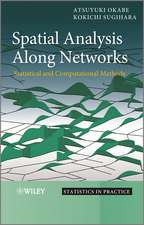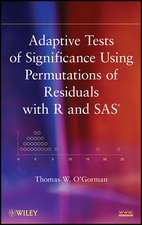Statistical Tools for Finance and Insurance
Editat de Pavel Cizek, Wolfgang Karl Härdle, Rafał Weronen Limba Engleză Paperback – 23 mar 2011
Features of the significantly enlarged and revised second edition:
- Offers insight into new methods and the applicability of the stochastic technology
- Provides the tools, instruments and (online) algorithms for recent techniques in quantitative finance and modern treatments in insurance calculations
- Covers topics such as
- expected shortfall for heavy tailed and mixture distributions*
- pricing of variance swaps*
- volatility smile calibration in FX markets
- pricing of catastrophe bonds and temperature derivatives*
- building loss models and ruin probability approximation
- insurance pricing with GLM*
- equity linked retirement plans*(new topics in the second edition marked with*) - Presents extensive examples
Preț: 646.62 lei
Preț vechi: 760.73 lei
-15% Nou
Puncte Express: 970
Preț estimativ în valută:
123.73€ • 129.18$ • 102.40£
123.73€ • 129.18$ • 102.40£
Carte tipărită la comandă
Livrare economică 05-19 aprilie
Preluare comenzi: 021 569.72.76
Specificații
ISBN-13: 9783642180613
ISBN-10: 3642180612
Pagini: 442
Ilustrații: IV, 420 p. 8 illus. in color.
Dimensiuni: 155 x 235 x 20 mm
Greutate: 0.59 kg
Ediția:2nd ed. 2011
Editura: Springer Berlin, Heidelberg
Colecția Springer
Locul publicării:Berlin, Heidelberg, Germany
ISBN-10: 3642180612
Pagini: 442
Ilustrații: IV, 420 p. 8 illus. in color.
Dimensiuni: 155 x 235 x 20 mm
Greutate: 0.59 kg
Ediția:2nd ed. 2011
Editura: Springer Berlin, Heidelberg
Colecția Springer
Locul publicării:Berlin, Heidelberg, Germany
Public țintă
ResearchCuprins
I Finance: Models for heavy-tailed asset returns (Szymon Borak, Adam Misiorek, and Rafa l Weron).- Expected shortfall (Simon A. Broda and Marc S. Paolella).- Modelling conditional heteroscedasticity in nonstationary series (Pavel Cížek).- FX smile in the Heston model (Agnieszka Janek, Tino Kluge, Rafał Weron, and Uwe Wystup).- Pricing of Asian temperature risk (Fred Espen Benth, Wolfgang Karl Härdle, and Brenda Lopez Cabrera).- Variance swaps (Wolfgang Karl Härdle and Elena Silyakova).- Learning machines to help predict bankruptcy (Wolfgang Karl Härdle, Linda Hoffmann, and Rouslan Moro).- Distance matrix method for network structure analysis (Janusz Mískiewicz).- II Insurance: Building loss models (Krzysztof Burnecki, Joanna Janczura, and Rafał Weron).- Ruin probability in finite time (Krzysztof Burnecki and Marek Teuerle).- Property and casualty insurance pricing with GLMs (Jan Iwanik).- Pricing of catastrophe bonds (Krzysztof Burnecki, Grzegorz Kukla, and David Taylor).- Return distributions of equity-linked retirement plans (Nils Detering, Andreas Weber, and Uwe Wystup).- Index.
Recenzii
From the reviews of the second edition:
“Individual papers in this book could easily be considered for publication in many fine journals of finance … . In all the papers, the documentation is well done, with a good deal of simulation studies to exemplify the processes under consideration. I would recommend this book for the library of serious researchers in field of the economic analysis of financial markets as well as those in statistical research in applied fields. Mathematical economists as well as statistical researchers will find the volume useful … .” (Jeffrey E. Jarrett, Technometrics, Vol. 54 (1), February, 2012)
“Individual papers in this book could easily be considered for publication in many fine journals of finance … . In all the papers, the documentation is well done, with a good deal of simulation studies to exemplify the processes under consideration. I would recommend this book for the library of serious researchers in field of the economic analysis of financial markets as well as those in statistical research in applied fields. Mathematical economists as well as statistical researchers will find the volume useful … .” (Jeffrey E. Jarrett, Technometrics, Vol. 54 (1), February, 2012)
Notă biografică
Pavel Cížek is professor of econometrics and statistics at Tilburg University. He teaches various courses covering time-series, simulation-based, and semiparametric estimation methods. His research interests are methods of semiparametric and robust statistics and econometrics with applications primarily in microeconomics and quantitative finance.
Wolfgang Karl Härdle is professor of statistics at the Humboldt-Universität zu Berlin and director of C.A.S.E. – the Centre for Applied Statistics and Economics. He teaches quantitative finance and semiparametric statistical methods. His research focuses on dynamic factor models, multivariate statistics in finance and computational statistics. He is an elected ISI member and advisor to the Guanghua School of Management, Peking University.
Rafał Weron is professor of economics at Wrocław University of Technology (WUT). His research focuses on developing risk management and forecasting tools for the energy industry and computational statistics as applied to finance and insurance. He is periodically engaged as a consultant to energy (Tauron Polska Energia, Vattenfall) and financial (BRE Bank, Bank Millennium) companies. He teaches graduate level courses on energy and financial markets at NTNU (Trondheim) and WUT.
Wolfgang Karl Härdle is professor of statistics at the Humboldt-Universität zu Berlin and director of C.A.S.E. – the Centre for Applied Statistics and Economics. He teaches quantitative finance and semiparametric statistical methods. His research focuses on dynamic factor models, multivariate statistics in finance and computational statistics. He is an elected ISI member and advisor to the Guanghua School of Management, Peking University.
Rafał Weron is professor of economics at Wrocław University of Technology (WUT). His research focuses on developing risk management and forecasting tools for the energy industry and computational statistics as applied to finance and insurance. He is periodically engaged as a consultant to energy (Tauron Polska Energia, Vattenfall) and financial (BRE Bank, Bank Millennium) companies. He teaches graduate level courses on energy and financial markets at NTNU (Trondheim) and WUT.
Textul de pe ultima copertă
Statistical Tools for Finance and Insurance presents ready-to-use solutions, theoretical developments and method construction for many practical problems in quantitative finance and insurance. Written by practitioners and leading academics in the field, this book offers a unique combination of topics from which every market analyst and risk manager will benefit.
Features of the significantly enlarged and revised second edition:
Features of the significantly enlarged and revised second edition:
- Offers insight into new methods and the applicability of the stochastic technology
- Provides the tools, instruments and (online) algorithms for recent techniques in quantitative finance and modern treatments in insurance calculations
- Covers topics such as
- expected shortfall for heavy tailed and mixture distributions*
- pricing of variance swaps*
- volatility smile calibration in FX markets
- pricing of catastrophe bonds and temperature derivatives*
- building loss models and ruin probability approximation
- insurance pricing with GLM*
- equity linked retirement plans*(new topics in the second edition marked with*) - Presents extensive examples
Caracteristici
Offers insight into new methods and the applicability of the stochastic technology Provides the tools, instruments and (online) algorithms for recent techniques in quantitative finance and modern treatments in insurance calculations Presents extensive examples












